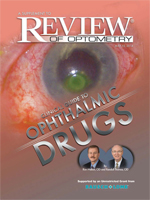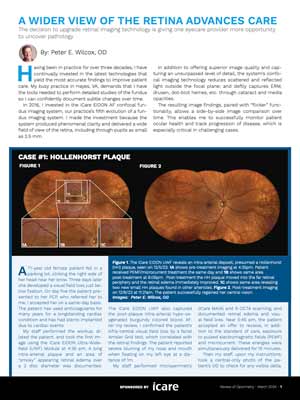Clinical Guide to Ophthalmic Drugs
—2014
Read Digital Edition
Since we last authored this annual work, there has not been a single new brand-name ophthalmic drug brought to market! This, however, does not deter us from sharing with you an abundance of new clini- cal and medical insights, and reiterating several points germane to the enhancement of patient care.
In this annual Clinical Guide to Ophthalmic Drugs , we share with you a large number of clinical pearls we have gleaned from over 65+ combined years of full-time clinical practice. Interestingly, our three main areas of professional interests center around anterior segment conditions, glaucoma and dry eye disease. Perplexingly, these same areas are ones in which we have observed less-than-optimum patient care. We think that in the case of anterior segment disease, suboptimum care is due to failure to use steroids when indicated; in glaucoma, it is due to failure to use pachymetry and to definitively diagnose glaucomatous optic neuropathy; in dry eye disease, it is due to failure to embrace pulse-dosing of topical steroids to suppress inflammation. Shortfalls in these three clinical areas can be rectified by thoughtful, enlightened and attentive clinical thought, and by taking note of the knowledge and insights we have gained through our years of clinical practice and share with you in this annual guide.
Beyond this, we passionately urge our colleagues to subscribe to one or both of the premier ophthalmology journals, Ophthalmology or American Journal of Ophthalmology . Over the years, we have gained enormous clinical empowerment by perusing these educational resources and trust you will do the same.
We expend considerable effort each year to bring this clinical guide to the profession of optometry. Our sole purpose is to do our best to enable you, our colleagues, to provide your patients the absolute best in clinical care.
Our very best wishes to each of you,
Ron Melton, OD Randall Thomas, OD, MPH.
Additional Publications
-
A Wider View Of The Retina Advances Care
The decision to upgrade retinal imaging technology is giving one eyecare provider more opportunity
to uncover pathology.Sponsored by iCare
It’s Time to Talk to Your Patients about Digital Eye Strain
New Developments in Glaucoma
Ophthalmic Product Guide - February 2024
Preservatives in Eye Care: Intrepid Eye Society Consensus Discussion
2024 Conference Planner



